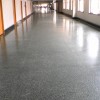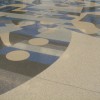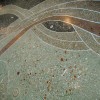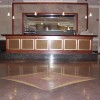Terrazzo Flooring
Terrazzo, derived from the Italian word "terrace," is thought to have been first put to use in 15th century Venice. A vast amount of terrazzo remains in Italy's ancient architecture from this time period, supporting this assumption; however, archaeologists have also discovered the use of a matrix and marble chip flooring system used in Turkey that may be as much as 10,000 years old. Italian craftsmen historically used discarded marble chips to create floors on exterior terraces around their homes. The marble chips were embedded in clay, and when the clay dried, the surface of the flooring was ground down, making it smooth and durable.
Terrazzo was introduced to America in the 1700's by European craftsmen. Although over the years modern methods and materials have changed, the basic construction techniques and appearance of terrazzo have remained similar. Unlike tile, terrazzo is a seamless composite material which is poured in place.
Traditionally, terrazzo has been created on the job site. For this method of construction, a damp, sandy cement mixture is poured over a prepared sub-floor to act as the base and binder. The typical thickness for this type of terrazzo is between 2 1/2" and 3". A variety of marble chips is then spread over the clay surface. Depending on the design, colored pigments can also be added at this time. The entire surface is rolled to evenly compact the area before the concrete binder can dry. Divider strips are incorporated to control the work areas, create designs, and perform other functional requirements, such as controlling cracking or accomplishing a change in surface direction. Divider strips are made using a white alloy containing zinc and brass, and with today's technology, sometimes even plastic. After the concrete has dried, the surface is ground to be uniformly flat and smooth. For centuries this step was laboriously performed by hand-grinding with stones, but today it is accomplished with diamond impregnated stones and electric grinding machines. This method results in a smooth, dense, and highly polished surface, which is then sealed to retain the polished appearance.
Modern materials have increased the variety of uses for this product. Epoxy and polyacrylic materials have created a terrazzo product that is 1/4" to 3/8" in thickness and weighs only 3 to 5 lbs. per sq.ft.. This allows architects and designers to use the product in places where traditional terrazzo, at 25 to 35 lbs. per sq.ft., would be unacceptable. Other interesting terrazzo products can be created using these types of materials. Larger precast pieces are cut into smaller tile sections for floor covering or strips to used as window sills. This has created an affordable residential market for the high end appearance and durability of terrazzo.
Terrazzo was one of the original "green" building products, as it was created by reusing discarded building materials, and it continues to lend itself to the development of green products. The aggregates and chips used in terrazzo can be made of almost any recycled material, including glass, granite, and stone, or even plastic. Terrazzo itself can be recycled. The materials in terrazzo are compounded of zero VOC (Volatile Organic Compounds) materials and exhibit little or no out-gassing of chemicals over the life of the cured product. The non-porous, cleanable surface does not support microbial growth, which leads to improved indoor air quality.
Terrazzo, with its unique appearance, timeless materials, durability, green building qualities, and ability to be used in a great many floor covering applications, is a popular choice for commercial buildings of all types, and is now expanding into the residential market. With all of these attributes, it is easy to see why terrazzo is regaining popularity in the floor covering market.





